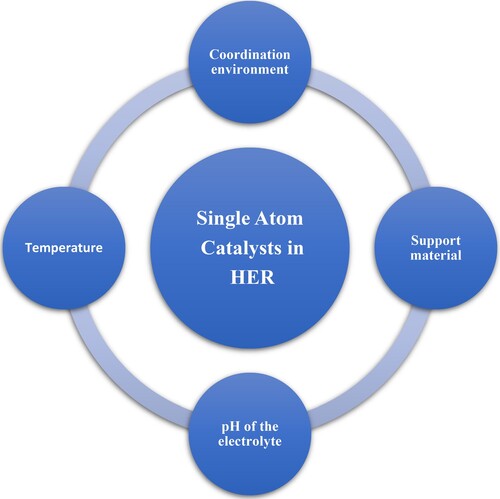Figures & data
Figure 1. Descriptors for hydrogen evolution on single-atom catalysts in nitrogen-doped graphene. Reproduced with permission from ref.[Citation36] Copyright 2020, The American Chemical Society.
![Figure 1. Descriptors for hydrogen evolution on single-atom catalysts in nitrogen-doped graphene. Reproduced with permission from ref.[Citation36] Copyright 2020, The American Chemical Society.](/cms/asset/31f8b2fd-d670-4f53-a9db-04b9ec1dc9c5/tphl_a_2343665_f0001_oc.jpg)
Figure 2. (a) 2D volcano plot, derived from DFT results on 55 Single Atom Catalysts (SACs) for the HER, assumes an H* intermediate. (b) 3D volcano plot considers both H* and HH (dihydrogen) intermediates. The colour scheme indicates activity levels, with red for high activity, blue for low activity, and instances of extremely low activity (log(i0) < −10) depicted in black. Reproduced with permission from ref. [Citation42] Copyright 2021, The American Chemical Society.
![Figure 2. (a) 2D volcano plot, derived from DFT results on 55 Single Atom Catalysts (SACs) for the HER, assumes an H* intermediate. (b) 3D volcano plot considers both H* and HH (dihydrogen) intermediates. The colour scheme indicates activity levels, with red for high activity, blue for low activity, and instances of extremely low activity (log(i0) < −10) depicted in black. Reproduced with permission from ref. [Citation42] Copyright 2021, The American Chemical Society.](/cms/asset/f5b04333-fc69-4ad7-9b31-ccab710e6b65/tphl_a_2343665_f0002_oc.jpg)
Figure 3. The surface stability diagram for a Rh atom on TiO2(110) displays variations based on Δµ(H) and Δµ(O), representing H and O chemical potentials. Colours denote different configurations: blue, light blue, and green show regions where Rh preferentially substitutes a six-coordinated surface Ti with zero, one, or two O vacancies (Rh1@TiO2, Rh1@TiO2−x, Rh1@TiO2−2x). Orange and pink zones indicate preferences for the supported Rh structure (Rh1/TiO2−x and Rh1/TiO2−2x), respectively. Reproduced with permission from ref. [Citation56]. Copyright 2021, Springer Nature.
![Figure 3. The surface stability diagram for a Rh atom on TiO2(110) displays variations based on Δµ(H) and Δµ(O), representing H and O chemical potentials. Colours denote different configurations: blue, light blue, and green show regions where Rh preferentially substitutes a six-coordinated surface Ti with zero, one, or two O vacancies (Rh1@TiO2, Rh1@TiO2−x, Rh1@TiO2−2x). Orange and pink zones indicate preferences for the supported Rh structure (Rh1/TiO2−x and Rh1/TiO2−2x), respectively. Reproduced with permission from ref. [Citation56]. Copyright 2021, Springer Nature.](/cms/asset/57b3be26-87e8-4202-bddc-e4d2d272f8ec/tphl_a_2343665_f0003_oc.jpg)
Figure 4. (a) Schematic illustration for the synthesis of Pt-GDY1and Pt-GDY2. Atomic-resolution HAADF-STEM images for Pt-GDY1 (b) and Pt-GDY2 (c). (d) HER polarisation curves for Pt-GDY1, Pt-GDY2. Reproduced with permission from ref.[Citation66] Copyright 2018, Wiley. (e) Schematic illustration for the synthesis of Pt-SA/ML-WO3. (f) HAADF-STEM image of Pt-SA/ML-WO3. (g) HER polarisation curves for Pt-SA/ML-WO3. Reproduced with permission from ref.[Citation67] Copyright 2021, Wiley.
![Figure 4. (a) Schematic illustration for the synthesis of Pt-GDY1and Pt-GDY2. Atomic-resolution HAADF-STEM images for Pt-GDY1 (b) and Pt-GDY2 (c). (d) HER polarisation curves for Pt-GDY1, Pt-GDY2. Reproduced with permission from ref.[Citation66] Copyright 2018, Wiley. (e) Schematic illustration for the synthesis of Pt-SA/ML-WO3. (f) HAADF-STEM image of Pt-SA/ML-WO3. (g) HER polarisation curves for Pt-SA/ML-WO3. Reproduced with permission from ref.[Citation67] Copyright 2021, Wiley.](/cms/asset/6a4806db-975c-4daa-a747-3affc96e3c54/tphl_a_2343665_f0004_oc.jpg)
Figure 5. Schematic diagram representing reaction parameters affecting single atom catalysts in electrochemical Hydrogen Evolution Reaction.

